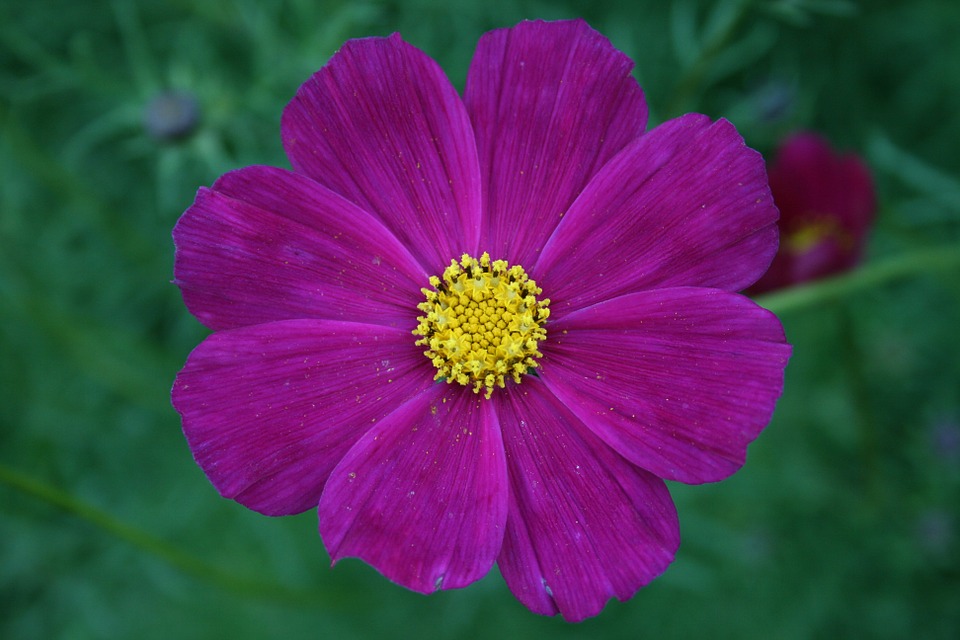
Students will:
- Name six parts of a flower.
- Dissect flowers.
- Observe each part of the flower and label it with descriptive and technical names.
- Microscopes
- Tweezers
- Tape or glue sticks
- Pieces of paper
- Flower Samples
- Flower Diagram – PDF
- Garden Journals
Activity Preparation
- Collect samples of flowers with pronounced parts.
- Draw the basic Flower Part diagram on the whiteboard.
Dissecting Flowers Using Observation
- Scientists use their senses to observe natural environments, especially when they are unfamiliar with them. Invite students to pretend like they have never seen a flower below.
- Direct them to use their eyes, ears, nose, and touch, to observe and identify each flower part.
- Prompt them to come up with creative names for each part based on what they observe.
- Demonstrate how they will dissect the flower, carefully retaining the structure of each part, tape it to their garden journals.
- Label each flower part using imaginative descriptions based on observation. Invite them to get creative, use correct spelling, and explore deeply.
- Use the flower diagrams for reference.
- Locate the outermost layer of flower parts. These are the sepals. Carefully remove the sepals. Record the numbers of sepals, attach one to the paper, and describe the function in your data table in your journal.
- Identify the petals. These form the next layer of flower parts. Carefully remove each petal.
- Locate the stamen, the male flower parts that are now being exposed. Record the number of stamen, attach one, and describe the function.
- Record the number of pistils.
Dissecting Flowers Using Scientific Names
- Invite students to now be a scientist as they further explore flower parts.
- Distribute flowers and review the different parts and their functions (see below).
- Prompt students to name as many parts as they can remember. Students take the flowers apart and tape them to the Flower Part diagram worksheet according to these steps:
- Locate the outermost layer of flower parts. These are the sepals. Carefully remove the sepals. Record the numbers of sepals, attach one to the paper, and describe the function in your data table in your workbook.
- Identify the petals. These form the next layer of flower parts. Carefully remove each petal.
- Locate the stamen, the male flower parts that are now being exposed. Record the number of stamen, attach one, and describe the function.
- Record the number of pistils.
- Ask: Is the scientific name for each part similar to the names you came up with? Why is it important for scientists to observe and use their imaginations when identifying plants?
Student Reflection
- Reflect on each flower part. What are the petals used for? How about the leaves and stem? What do we know about the stamen and sepals that would help us identify their function?
- Locate
- Observe
- Identify
- Record
- Document
The parts of the flower are usually found in whorls, or rings. Petals are one of the sets of whorls. Sepals lie outside the petals to protect the bud.
The reproductive organs, the stamens and pistils, lie inside the petals.
A stamen is a male reproductive part. It consists of an anther that is held up by a filament.
The anther produces pollen grains.
A pistil is a female reproductive part. Its top is called the stigma. It is sticky to ensure that when pollen grains land on it, they stick to it.
The middle supporting structure is the style, and the large base is the ovary, where the eggs are produced.
Academic Standards
Crosscutting Concepts
The shape and stability of structures of natural and designed objects are related to their function(s). Substructures have shapes and parts that serve functions.
Objects and organisms can be described in terms of their parts.
Disciplinary Core Ideas
Structure and Function: All organisms have external parts. Plants have different parts (roots, stems, leaves, flowers, fruits) that help them survive and grow. Different animals use their body parts in different ways to see, hear, grasp objects, protect themselves, move from place to place, and seek, find, and take in food, water and air.
Science & Engineering Practices
Use observations (firsthand or from media) to describe patterns and/or relationships in the natural and designed world(s) in order to answer scientific questions and solve problems. Use and share pictures, drawings, and/or writings of observations.
Use counting and numbers to identify and describe patterns in the natural and designed world(s).
This lesson is part of the Berkeley Unified School District's Gardening and Cooking Program curriculum.




